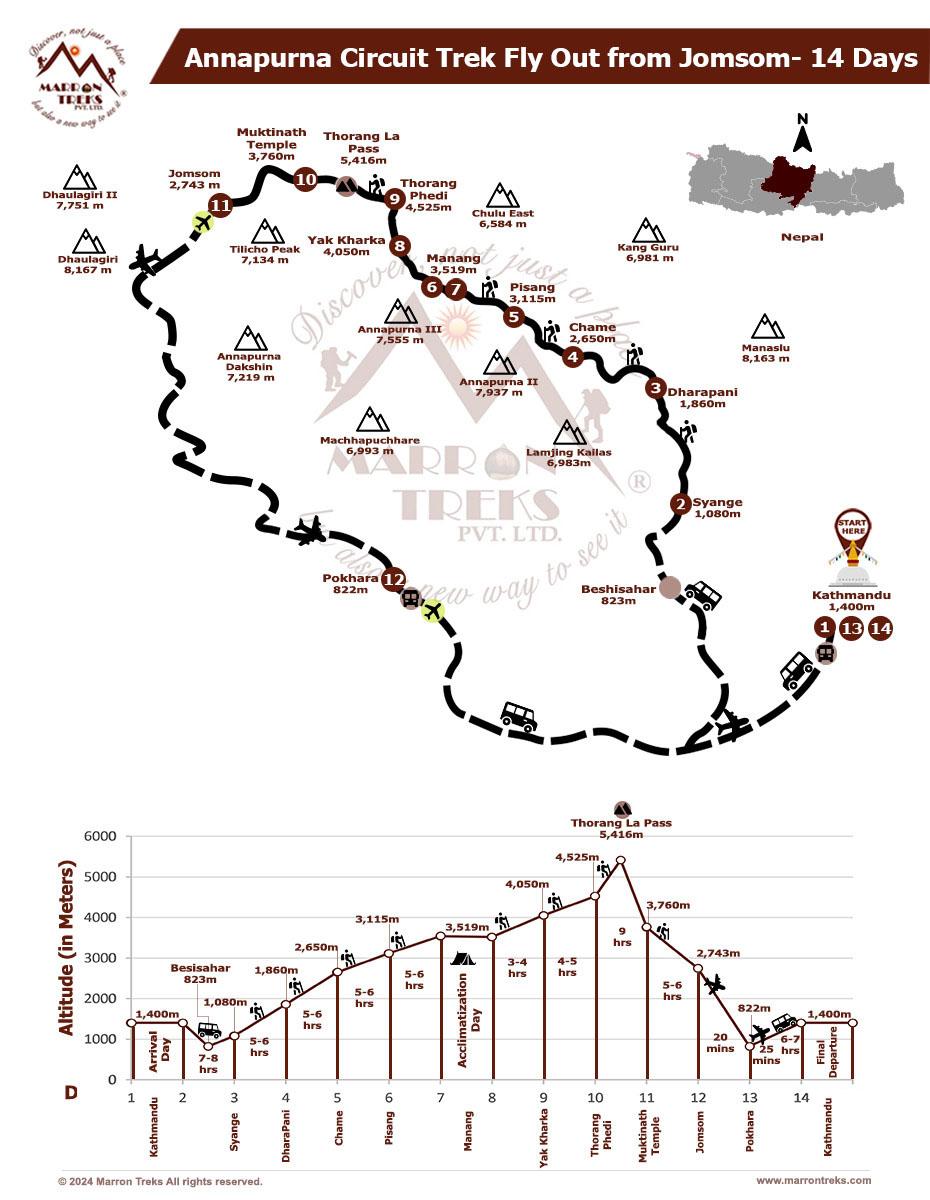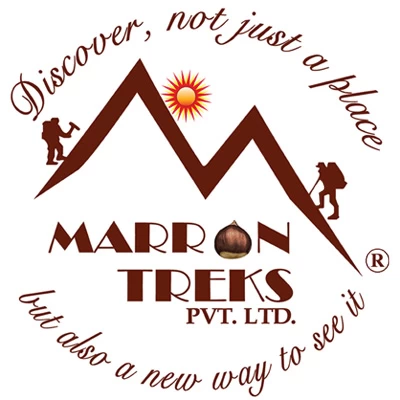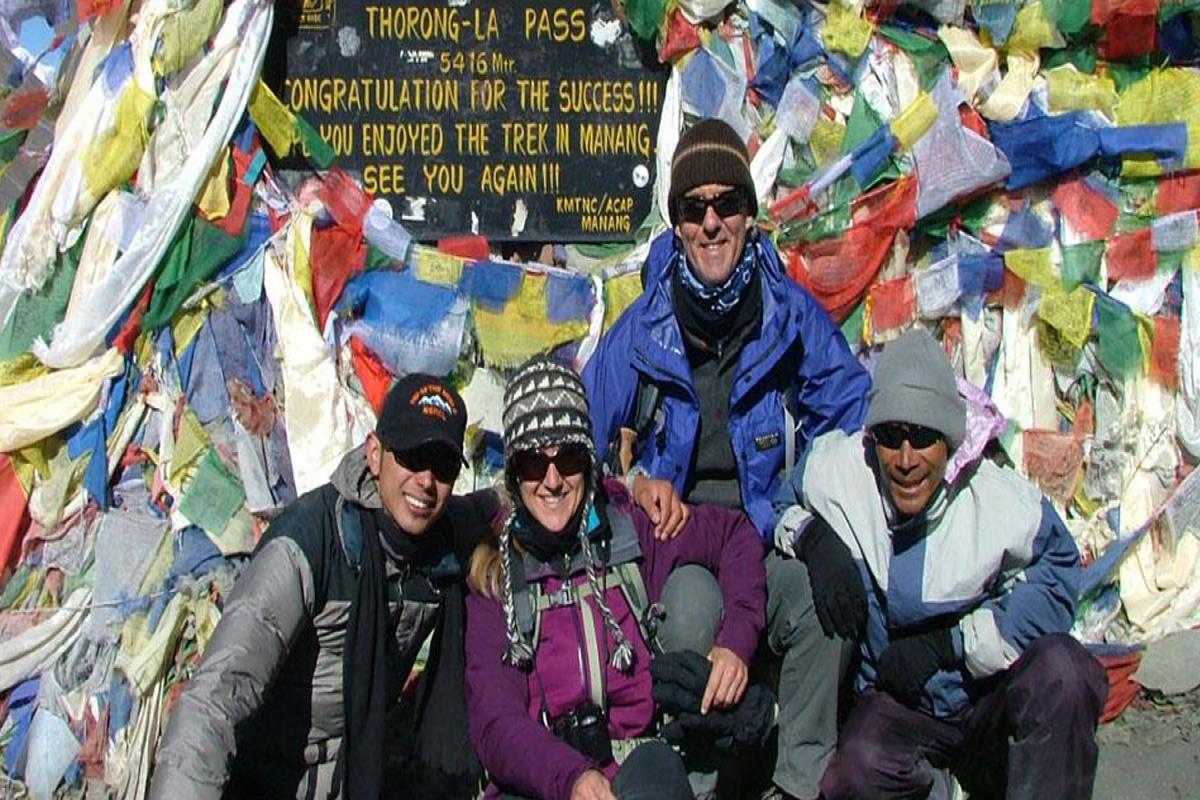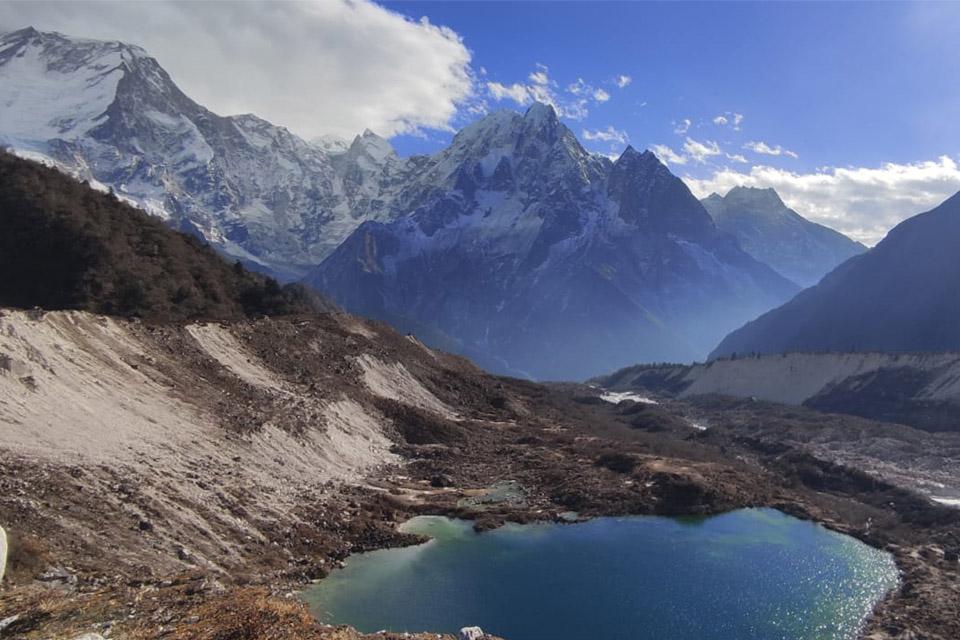Annapurna Circuit trek
Trip at a Glance
Annapurna Circuit trek is a complete hiking program in the Annapurna region that offers spectacular mountain panoramas, diverse landscapes and rich cultural heritage. Annapurna Circuit or round trek of Annapurna so it’s called is considered one of the most beautiful treks in the world. Spectacular views of peaks like Annapurna, Gangapurna, Dhaulagiri, and Machhapuchhre will greet trekkers along the trail.
Annapurna circuit trek itinerary passes through varied landscapes that go from rugged terrain to lush forests and traditional villages. You will come across majestic views of some of the world’s highest peaks like Annapurna, Dhaulagiri, and Nilgiri. One needs to have a good level of fitness and requires adaptation to the different climatic conditions. You will witness a unique local cultures and customs of the various communities living in the high Himalayas adding more to your overall trekking experience.
The trek to Annapurna Circuit begins after a scenic drive from Kathmandu to Syange from where you will begin your trek. As the trek proceeds forward you will trek along diverse landscapes and beautiful villages showcasing the traditional Nepalese way of life. The trekking trail of Annapurna Circuit is filled with lush forests, cascading waterfalls and majestic mountain views making Annapurna Circuit trek an extraordinary experience.
The prime highlight of the trek is crossing over the high mountain pass known as Thorong La Pass. This is the highest point of the trek Pass located at an altitude of 5,416 meters. Upon reaching the top of the pass you will be rewarded with a spectacular panorama of the entire Annapurna Range and the surrounding region.
After Thorong La, you will get down to Jomsom where the trek eventually ends. Jomsom is a gateway to the Mustang region and a popular destination for trekkers and travelers. From Jomsom you will take a short flight of about 20 minutes to the beautiful lakeside city of Pokhara.
Annapurna Circuit Trek is a challenging yet rewarding adventure in the Himalayas and it’s to experience the beauty of the Himalayas and immerse oneself in the rich culture of Nepal.
Annapurna Circuit trek Highlights
- Stopover at Pokhara- the natural wonder of Nepal.
- Hike at one of the world’s highest pass - Thorong La Pass (5,416m)
- Machhapuchhre, Mt. Annapurna south, Dhaulagiri, Annapurna I and others.
- Trekking past traditional villages, deserted land, stunning waterfalls with panoramic Himalayan views.
- Visit the sacred Muktinath Temple with 108 stone faucets & burning eternal flame.
- Visit the windswept town of Jomsom – the headquarters of Mustang.
Itinerary
Day 01: Arrival in Kathmandu (1400m)
Day 02: Drive from Kathmandu to Jagat (1300m) via Beshishar (823m/8-9 hrs Drive)
Day 03: Trek from Jagat to Dharapani (1,860m/6 hrs)
Day 04: Trek from Dharapani to Chame (2,650m/5-6 hrs)
Day 05: Trek from Chame to Pisang (3,115m/5 - 6 hrs)
Day 06: Trek from Pisang to Manang (3,540m 5 - 6 hrs)
Day 07: Rest and acclimatization day at Manang (3,519m)
Day 08: Trek from Manang to Yak Kharka (4,020m/3-4 hrs)
Day 09: Trek from Yak Kharka to Thorong Phedi (4,525m/4-5 hrs)
Day 10: Trek from Thorong Phedi to Muktinath Temple (3,760m) via Thorong La High Pass (5,416m/8-9 hrs)
Day 11: Trek from Muktinath to Jomsom (2,743m/5-6 hrs)
Day 12: Fly from Jomsom to Pokhara (822m/20 minutes)
Day 13: Flight or drive from Pokhara to Kathmandu (1400m/25min)
Day 14: Final Departure
Arrive in Kathmandu and one of our representatives will receive you and then transfer to your hotel in Kathmandu. The rest of the time is free to explore the city where your hotel is located which is usually at Thamel – the popular tourist hub in Kathmandu where every needs and facilities for the tourist are located like hotels, pubs, restaurants, departmental stores, trek gear shops etc. Or you can simply rest at your hotel if you are jet lagged and get ready for an amazing Himalayan trek.
We're going to drive to Jagat in a private tour car today from Kathmandu. Depending on traffic and road conditions, the travel could take eight to nine hours. There is concrete and paving on the road leading to Besisahar.
For a maximum of two to four hours, we will experience an exciting dirt road trip from Besisahar to Jagat. We'll designate the best car for the conditions of the road. All of our drivers have extensive experience and hold valid licenses to drive on public roads.
If the weather permits, you can also see stunning scenery, rivers, and waterfalls throughout this trip, as well as peaks like Mount Machhapuchhre, Mount Lamjung, and Mount Annapurna II and III.
After breakfast, we set off on foot from Jagat, crossing a huge bridge close to Tal to approach the Manang district. The trail winds through fields of barley, rice, and potatoes; the waterfalls never stop accompanying us. One of the largest settlements in the Manang valley, Dharapani, is reached after passing past the village of Kodo.
We have breakfast today and then resume our hike. We will climb up to the settlement of Chame by navigating via a couple steep forested ridges and other landslide locations. But we shouldn't overlook raising our gaze, as the spectacular views of Lamjung Himal, Annapurna II, and Annapurna IV (7,525m) await us. We also find a few little hot springs, which should provide us with some temporary relaxation.
After breakfast today, we will travel through an extremely deep forest before arriving at the striking curved rock face that rises 1500 meters above the river valley. We will arrive to Bhratang Village, well-known for its apple orchards. After that, we go up a rocky trail through the Marshyangdi Valley to Paungda Danda, which is a gigantic rock face that slopes upward nearly 5,000 feet (1,500 meters) above the trail. Once you get past this final section of rock, Dhukur Pokhari offers breathtaking views across the valley. We hike for a long from here until we get in Pisang, where we spend the night.
You will take the upper trails which pass through Upper Pisang and Geru to reach the village of Barge. Barge village is popular for the Barge Monastery – the biggest in Manang. Along the trail you will come across several Buddhist shrines and monasteries and finally reaches the big town of Manang. The trekking trail provides fantastic views of Annapurna II, III, IV, Gangapurna, Pisang Peak, and Tilicho.
Today is rest day at Manang for better acclimatization to adjust with the increasing altitude and to avoid altitude sickness. You can rest at your lodge or explore around Manang town visiting nearby interesting places like Gangapurna and Ice lakes, the traditional Kangsar village, and Milarepa Cave – believed to be the meditation bode of Buddhist Guru Milarepa. Visiting Vraja village will take you to Himalayan Rescue Association where you will learn more about acute mountain sickness.
With better acclimatized in Manang the trek continues to Yak Kharka. Now the trail with tall trees changes to alpine grass and junipers. You might notice a few horses or yaks grazing on the meadows en route. Walking further will reach the small village of Gunsan which has flat mud roof houses. After crossing a small river on a wooden bridge will give you a hint that Yak Kharka is nearby which is a peaceful meadow – is nearby.
Now you will leave the Marsyangdi Valley and follow the Jharsang Khola towards Thorong Phedi. The trail passes through pine and fir forests to enter the high Himalayas which appear completely different as seen from the lowlands during the first half of the trek. If luck favours you might spot wildlife like blue sheep or even snow leopard en route. Thorong Phedi is the stopping point for trekkers to spend overnight before attempting to cross the Thorong La High Pass.
This day is the most challenging day of the entire trek which involves crossing Thorong La High Pass which is one of the highest passes in the world. You will ascend up to Thorong La then descend down to Muktinath. Afternoon will be too windy to cross the pass so you will start early morning battling icy air and high altitude but still enjoying the views. Upon reaching the top of the pass witness even great views of peaks like Khatungkang, Gangapurna, and Annapurna ranges.
After enjoying a great photographic moments you will descend to Muktinath enjoying another good view of Dhaulagiri. With continue descending will reach Muktinath temple. It’s the holy temple for both Hindus and Buddhists which has 108 water spouts and an eternal flame which is burning there for ages. Stay overnight at Muktinath.
Today is the last day of trekking and the route heads down the valley loosing elevation and gradually rejoining the Kali Gandaki River Valley bottom to reach Jomsom. Upon reaching Jomsom you may feel like a big change from the serene trails and villages which you passed during the trek. Rest and explore around in Jomsom town.
Take the early morning flight to Pokhara from Jomsom which is a short flight of about 35 minutes. Upon reaching Pokhara the rest of the time is rest at your hotel or explore the beautiful lakeside city of Pokhara. In the evening you can visit the lakeside area closer to Phewa Lake with many restaurants, pubs, eateries which is like the tourist hub of Thamel in Kathmandu.
After breakfast you can either choose to fly to Kathmandu from Pokhara (20 minutes) or take an overland drive to Kathmandu (6-7 hours drive). Upon reaching Kathmandu check-in hotel and the evening is all set for Farewell Dinner at one of the authentic Nepali restaurants.
The trip concludes and our office representatives will take you to the international airport in Kathmandu to catch your onward flight to your next destination or fly back home. You need to be at least 3 hours prior to your flight time at the airport.
Thank you for visiting Nepal and we hope your Himalayan Holiday has come true. Have a safe flight back home!
What is included?
- Airport pick-up and drop services.
- Hotel accommodations in Kathmandu & Pokhara with breakfast as per itinerary.
- Kathmandu to Jagat drive by private vehicle.
- All trekking accommodations with Breakfast/Lunch/Dinner at local lodges.
- Jomsom/Pokhara airfare
- Four seasonal sleeping bags (to be returned after trip completion) & Marron Treks duffel bags,
- Pokhara/Kathmandu transfers by a tourist bus or private vehicle (Option: Flight)
- A comprehensive medical kit (will be carried by the trekking guide)
- Experienced Government licensed English Speaking Guide & Porter (1 porter for two people) including their food, accommodation, salary & insurance.
- All applicable tourist fees, ACAP permit & TIMS fees necessary for trekking.
- All government and local taxes.
- Farewell dinner with Nepalese cultural program.
What is not included?
- International airfares.
- Nepal entry visa fee – Visa can be obtained upon your arrival at the Tribhuwan International Airport in Kathmandu. (USD30 for 15 days)
- Lunch & dinner in Kathmandu or Pokhara.
- Personal travel insurance.
- Emergency rescue evacuation (to be covered by the client's travel insurance).
- Other expenses of a personal nature (phone calls, laundry, battery recharge, extra porters, bottle or boiled water, hot shower etc.)
- Personal trekking equipment.
- Bar bills, alcoholic drinks & beverages.
- Tips for guide & porter.
Route Map

Trip Info
Accommodation
While you are in Kathmandu, we opt to accommodate you in 4- or 5-star hotels like Hotel Royal Singhi (4-star), Hotel Manaslu (4-star), Radisson (5-star), Yak & Yeti (5-star), or similar. During the trek, you will be accommodated in a local mountain lodge, better known as Tea House. These lodges and teahouses provide good services and are equipped with basic amenities. We will endeavor to provide you with the best accommodation available along the route so that you get a good night’s rest in a hygienic milieu.
Meals
We never compromise the quality of food or the health of the trekkers as well as the crew members. Generally, we opt for the fresh and nutritional local community food available. You could make your delicious pick from an array of traditional foods like Sweet potatoes, buckwheat barley, etc. This way, you could not only get a real sense of the local culture and life patterns but also contribute to promoting the locally available resources of organic food and beverages. Besides, a wide range of Continental, Chinese, Italian and Indian cuisines like Pizza, Spaghetti, French Fries, Soups, Breads, Masala curry, etc. are also available in the restaurants for your retreat.
Acclimatization
Altitude sickness is a serious risk while trekking in the Himalayas. It's important to acclimatize properly by spending a few days at lower altitudes before heading higher. By spending time at lower altitudes before pushing higher, your body has time to adjust. Our trekking packages have enough acclimatization days planned where you'll be spending a day or two at lower altitudes, allowing your body to adjust to the increasing altitude.
Electricity & drinking water
For an additional cost, you can use the electricity in all tea houses and lodges to recharge your batteries. The lodges have packaged mineral water for sale, or you can fill your bottle with boiling water. To make water drinkable, you can use water purification tablets too. But, due to hygienic issues, you should avoid drinking water from taps, rivers, or wells in trekking areas.
Communication
At lodges, restaurants, and hotels, Wi-Fi is available for an additional fee in the most popular trek regions, like Everest, and Annapurna. However, at high elevations, phone calls are the only means of connection. Our office in Kathmandu is in constant communication with your trek guide. In Kathmandu, you can purchase a local sim card for communication purposes. At high elevations, the mobile signal might not be as strong, though.
Luggage
Our porters are paired with one trekker for every two hikers, and one porter can safely carry 30 kg maximum weight. Therefore, we advise you to fill your duffle bag not more than 15 kg with your belongings. You may carry a small backpack with your valuables and informational documents. The things you are not taking along on the trek can be stored in a hotel in Kathmandu free of cost.
Typical Trek Day
Mostly your trek day starts with breakfast at 7-8 am, followed by a 3-4 hour morning trek. Lunch break is around an hour, then you continue trekking to your destination for the day. After reaching the teahouse lodge, you can relax, explore nearby areas, and enjoy dinner at 6-7 pm. Evenings involve socializing, a trek briefing, and leisure activities before bed.
Travel Insurance
It is advised that you arrange your travel insurance before leaving your homeland. The main thing is to make sure that your insurance covers you for both- medical and evacuation costs. Having travel insurance with you makes your trip secure and hassle-free.
Our Guides
Guides play a significant role during the trek. They are the ones who literally decipher the trekking codes for you so that you can actually connect with nature, culture and people along the way. We have helpful and dedicated trekking guides who are very well-versed in the culture, life patterns and every single detail pertaining to the trek region you are traveling in. Thus, in the company of our professional Sherpa guides, your trek becomes not only entertaining but also equally informative.
Porter and Staff Care
When it comes to high-altitude trekking, porters and staff members make up a pivot. Marron Treks ensures that all the porters and staff members going to high altitudes are provided with adequate clothing and equipment. All our field staff are covered by insurance.













